
|
| No matter what anyone may tell you, nationalism has affected every continent on this planet. |
Obviously, nationalism has been both invaluably positive and irreparably detrimental to our world. Just as the concept can't be narrowed down to fit our ideas of "good" and "bad", neither can it be relegated to only certain areas of the globe. Nationalism has affected every society and culture on this planet, yet our Eurocentric minds have placed most of the importance on Europe's nationalism boom in the 1800s.
The most successful nationalistic attempts took place in South America, before most of the European nations actually got around to bringing down their absolute monarchs. More recently, nationalism has spread in Asia. The craze started out in China in the early 1900s, mainly fueled by resent for the Europeans who had dominated its eastern coastal cities for the past few years. People in Indonesia, Burma, Korea, and Vietname all made efforts to gain full independence, and most were successful.
In central asia and the middle east, most of the nations were able to overthrow their oppressors (mainly the British, and mainly in Afghanistan, India, and Arabia), whether it be by peaceful or forceful means.
Most recently, the African nations rid themselves of their mostly European leaders. A good example of this would be the fall of Apartheid in South Africa, thanks to the leadership of Nelson Mandela.
No matter which way you look at it, nationalism is a multifaceted and far-reaching concept. It's not just for Europeans anymore.
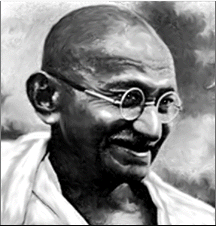
|
| Thanks to Mahatma's peaceful protest, the British were soon Gone-dhi from India! |
"Nonviolence is the greatest force at the disposal of mankind. It is mightier than the mightiest weapon of destruction devised by the ingenuity of man."
-Mahatma Mohandas K. Gandhi
Gandhi was unlike most nationalist activists in that he did notadvocate the use of violence to overthrow India's British oppressors. However, he was no less effective. In fact, he was much more effective than most of the previous nationalists who had attempted to gain power using force.
With his success, Gandhi ushered in a new era of peaceful protest, which, while not eliminating the chance of violent uprisings, certainly provided a rational alternative to armed rebellion.
Without taking a single violent action against his oppressors, Gandhi was able to gain independence for one of the largest nations in the world, and, at the same time, strike a crippling blow to the British Empire. India's solidarity proved to be one of the final death knells of the United Kingdom's vast overseas regime, eventually relegating the empire back to the relatively tiny confines of the British Isles.
GANDHI FACT LIST:
-born in 1869 to a Hindu family in Gujarat State, Western India
-married Kasturbai Makanji when they were both 13; the union was arranged
-studied law in London; called to the bar in 1891
-he moved to South Africa and set up practice
-he worked tirelessly for the rights of immigrant Indians in South Africa, and formulated his ideas for nonviolent protest, or "satyagraha", there, and was frequently jailed because of it
-he returned to India in 1915, having left an indelible impact on the Indian population of South Africa
-while in India, he spread his ideas of peaceful resistance and religious tolerance, but the Muslims and Hindus of India still fought against eachother and against the British
-each time violence erupted, whether it was between Britain and India, or the Hindus and the Muslims, Gandhi fasted until the quarrelling ceased
-India finally gained independence in 1947, thanks to the willpower of the Mahatma and his followers
-Gandhi was still displeased, however, that British India was divided into two new nations: Muslim Pakistan and Hindu India
-in the times between India's independence and his death, Gandhi fasted to a degree that approached suicide in protest of the new violence raging between the Muslims and the Hindus; luckily, his protests were able to quell much of the violence
-Gandhi was killed in January, 1948, only shortly after India's independence, when an assassin murdered him in a crowded garden as the Mahatma was preparing for his evening prayers
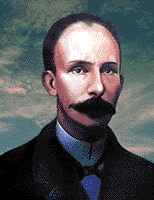
|
| Jose Marti was one of the many nationalist leaders of Latin America who drove out the Spaniards. |
Jose Marti was one of many Latin American nationalists who fought for their independence from Spanish or Portuguese rule. While he accomplished little from a military or political standpoint, Marti's literary contributions were extremely effective. His writings and ideas were mainly ignored during his lifetime, but during the Third Cuban Nationalist Movement of the 1920s/30s, he was recognized as the nationalist innovator and leader he was.
Jose Marti Fact List:
-born in 1853 in Cuba to poor Spanish immigrants
-entered high school at around the same time as the first Cuban struggle for independence, the Ten Years' War
-published his first newspaper, La Patria Libra (Free Fatherland), in 1869
-arrested for denouncing Spain and sentenced to six years' hard labour; he was released after only a few months
-Marti then went into exile, first to Spain, where he wrote El Presidio Político en Cuba, a work denouncing Cuban prisons
-he studied at the universities of Madrid and Zaragoza
-he then moved to New York, where he wrote for various South American newspapers, and also worked on a children's magazine and poetry
-he praised the United States for its industriousness and constitution, but he disliked its European-esque attitude towards Latin America
-in 1892 he put his plans for a second Cuban struggle for independence into action, forming the Cuban Revolutionary Party, which he hoped would uphold the ideals of Republicanism, much like the French revolutionaries; Marti was afraid that Cuba might fall into a military dictatorship if freed from Spain, unless the revolutionaries were committed republicans
-Marti predicted that the war for independence would have to be short, in order to avoid American interference
-in 1895, Marti was prepared to free Cuba; he had ships, soldiers and generals from the Ten Years' War, and supplies waiting to be sailed from Fernandino, Florida to the island of Cuba
-Marti's worst fears came true when American authorities seized most of his ships in Florida, and Marti was left with scattered troops and general disorganization once he reached Cuba
-Marti, who led a grand, epic life, died in a most pedestrian manner when he was shot in a minor skirmish shortly after his arrival to Cuba
-post mortem, Marti's works came into their own as nationalist, revolutionary masterpieces, and he was considered a hero by most of the Latin American population

|
| Don't let his rag-tag appearance and illegitimate birth fool you, Sandino knew what he was doing. |
"The sovereignty and liberty of a people are not to be discussed, but rather defended with weapons in hand."
-Augusto Sandino
Augusto Sandino was a Nicaraguan nationalist who had more in common with a Garibaldi than a Gandhi. While Sandino never gained any real political power, like Garibaldi, he was instrumental in the taking of Nicaragua from Consvervative power and American imperialistic control. He believed in the rights of the individual, so much so that he would die for them. He was passionate about a Nicaraguan constitution, and about removing all American influence from his country. In the end, though his life was cut short, he was able to live to see those passions realised.
Augusto Sandino Fact List:
-born in Niquinohomo, Nicaragua, in 1895, illegitimately, to his peasant worker mother and her boss
-he was abandoned by his mother at age 10, but went on to spend time at his grandmother's and, later, at his father's home, where he felt extremely unwelcome
-in 1921 he shot, but didn't kill, Dagoberto Rivas, a local conservative who had made some rude comments about Sandino's mother
-he fled to Mexico, where he became involved with various radical groups while working for Standard Oil
-Sandino returned to Niquinohomo in 1926 (the statute of limitations on his shooting crime had run out) where he hoped to start a business; however, Dagoberto Rivas got his revenge on Sandino by repeatedly blocking his attempts at entrepreneurship
-Sandino moved north to a small mining town, where he began to spread nationalist influence over the miners, convinving them to rebel; he bought some guns (using his life savings) off of some Honduran gun-runners and armed the miners
-the miner-soldiers attacked the city of El Jicano, but were handily defeated by the garrison there; Sandino decided he needed better weapons and smarter tactics
-at this point, the Liberal opposition to Nicaragua's conservative government had started to take military action in order to take power; Sandino contacted the Liberal leader, General Moncada, asking for weapons and troops; Moncada declined, but Sandino became so popular within the liberal community that the General was eventually forced to aid him
-with Liberal troops and new weapons, Sandino started a guerilla campaign against the establishment; his tactics would influence soldiers in the Vietnamese War, and again in Nicaragua with the Sandanistas and Contras in the 1980s
-the United States, hoping to end the civil war, proposed a peace treaty between the Liberals and the Conservatives; all of the Liberals save for Sandino agreed to the Americans' terms; Sandino wouldn't lay down his weapons until the American imperialists were banished from Nicaraguan soil
-the Americans left for good in 1933, and Sandino agreed to end the fighting and sign a peace treaty with the new Sacasa government led by President Somoza; Sandino's men would form a military force under Somoza's control, and Sandino and his party were allowed to go live in peace in an Northern Nicaraguan commune
-the men now udner Somoza's control were formed into a National Guard, which was supposed to keep the country stable so development could be encouraged; however, Somoza soon began to use the guard for his own, personal vendettas and political causes
-Somoza's abuse of the National Guard system didn't sit well with Sandino, and he went to talk with the President about these unconstitutional practices
-Somoza agreed to lessen his power over the national guard, but, as Sandino was leaving, he had the guard surround Sandino and his party, and execute them all
-the next day, the guard massacred the men, women, and children remaining in the Northern Commune
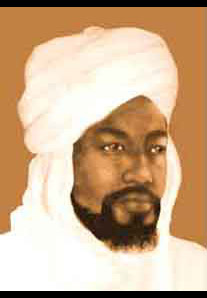
|
| The Mahdi fought to free Sudan, and soon the Egyptian invaders were saying Su-Long to his country. |
Little is known about the Mahdi, but what we do know gives us some interesting implications. In 1881, Muhammad Ahmad declared himself al-Mahdi ("the awaited one"), the messiah of the Muslims, and began the Mahdist conquest of Sudan. Al-Mahdi fused nationalism and religion into a cohesive military and political unit that was able to overcome all odds and defeat the Anglo-Egyptian coalition at Khartoum, ending Egypt's occupation of northern Sudan. Although, al-Mahdi died soon after, his success at creating an independent Muslim state influenced many similar emerging nations such as Pakistan and Libya. Some might even go as far as to claim that al-Mahdi was the 19th-century-precursor to Osama bin-Laden, and other modern day Muslim terrorists who claim divinity. While al-Mahdi fought straight-on battles, not guerilla/terrorist ones, his style of motivation much mimics today's Middle East dictators.

|
| America's first President was successful in Wash-ing the British stain out of the thirteen colonies. |
America's first President, George Washington, is probably the most well-known nationalist figure in existence. While for the most part soft-spoken, Washington still firmly denounced British taxation and domination of American markets. He was the first to lead the United States both militarily and, later, politically. He was astoundingly popular among both the politicians and the commoners of the newly formed nation, and he chose a path of moderation, both before and after American gained its independence.
While Washington was a man of principle and skill, he was a reluctant leader. His greatest wish was for a cooperative government and neutral international stance. He wished to retire to his estate in Virginia after the War of Independence, but his fellow politicians knew he was needed to lead the new country on a path of success.
Washington Fact Sheet:
-born in 1732 in Virginia to a rich plantation family
-as a teen, he became interested in military tactics and westward expansion; at 16, he surveyed Shenandoah native lands for Lord Fairfax
-in 1754, he was commisioned a Lt. Colonel, and fought in the French-Indian War
-in 1755, Washington had six (!) brushes with death, when bullets ripped through his coat 4 times, and two of his horses were killed while he was riding them
-from 1759-1775, Washington lived in Virginia, managing his property, and growing increasingly disillusioned with the British taxation; he began to discuss his distate for the system with fellow Virginian politicians
-in 1775, at the Second Continental Congress, Washington was chosen as Commander of the Continental Army
-using innovative surprise tactics and French aid, Washington was able to lead his rag-tag group of soldiers to victory over the British in 1781
-in 1787, Washington attended the Constitutional Convention in Philadelphia, where he was unanimously elected President by the electoral college
-when the French Revolution lead to military conflict between France and Britain, Washington ignored his main advisors: Jefferson, his Secretary of State, who supported the French, and Hamilton, Secretary of Treasury, who was pro-British; Washington remained neutral
-Washington was distressed by the fact that, by the end of his first term, two distinct political factions were forming
-when he retired in 1796, Washington warned against excessive partisanship and long-term international alliances
-he died of a throat infection in 1799, at his Mount Vernon home
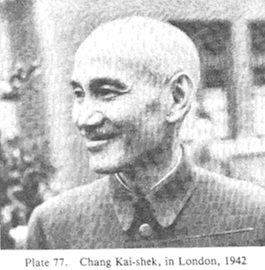
|
| Generalissimo Chiang Kai-shek Kai-shocked the world with his ruthless treatment of dissenters. |
Chiang Kai-shek is a more modern example of nationalism, and, more importantly, nationalism gone wrong. Although Chiang was known as a butcher of resisters by the peasants of China, he still received strong support from the United States and most other western countries. During WWII, he was even named Supreme Commander of Allied Forces within the China Theatre.
Chiang's life was also characterized by his long-standing feud with Mao Zedong, eventual Communist Chairman of China. Both he and Mao came from the leadership of Sun Yat-sen, the leader of the United Revolutionary League, which eventually metamorphosized into the Kuomintang (Nationalist Party) under Chiang's control.
After the removal of the Qing dynasty in 1911, Chiang was the first to gain power, but his ruthless totalitarianism would eventually lead to his downfall at the hands of Mao.
Chiang Fact List:
-born in Fenghua, Zhejiang Province in 1887
-studied in Japan, where he fell under the influence of the radical Sun Yat-sen
-in 1911-1912, the Qing dynasty is overthrown, and the Republic of China is declared
-after a rocky decade of coexistence, Chiang ordered the destruction of Mao's (and his associate, Zhou Enlai's) Communist Party.
-the Communists, for the most part, eluded Chiang's grasp; Mao led them on the famous Long March of 1934, the longest retreat in military history (although, this retreat, unlike most, was actually a benficial military move); however, the Communists couldn't escape the massacres committed by the Kuomintang in major Chinsese cities, where Chiang brutally slaughtered the socialists and their families, including Mao's first wife
-while attempting to weed out the communists, Chiang was also fighting a war against the Japanese, who had invaded Manchuria in 1931
-in 1942, Chiang is named the Supreme Commander of Allied Forces in the China Theatre
-when the Japanese were finally defeated in 1945, civil war re-erupted between the Communists and the Kuomintang
-between 1947 and 1949, the communists conducted a full-scale attack on the Kuomintang, eventually capturing the entire Chinese mainland
-Chiang was forced to move to the island of Taiwan, where he was successful in winning political support and creating a successful economy; however, Taiwan's economy was hurt by the opening up of Communist China to Western interests in the 1970s
-Chiang died in Taiwan in 1975

|
| David ben-Gurion has ben-busy becoming the first Prime Minister of Israel. |
David ben-Gurion, along with Vladimir Jabotinksy and Yitzhak ben-Zvi, was one of the most instrumental people in the creation of the Israeli state in 1948. From early on in life, ben-Gurion was an admant Zionist (he supported the return of Hebrews to their homeland of Israel). He joined and formed several Zionist organizations throughout his life, including the "Poalei Zion" and "Ezra".
Even before Israel was formally recognized as a state, ben-Gurion travelled to his holy land to establishes kibbutzes (Hebrew communes) and rouse Zionist support in the Middle East. Eventually, he was deported by the Ottoman rulers, but he went on to New York, where he was able to join with a large Zionist community and gain much support for his cause.
Ben-Gurion also founded many trade unions to aid Jewish workers, the most important union being the Histadrut. These unions were extremely socialist, which cause Zionism to be be associated with that form of government.
As Israel's first Prime Minister, ben-Gurion led the nation to many military, economic, and political victories. He stayed in politics for most of his later life, becoming Prime Minister twice, and forming several political parties, such as Rafi ("List of Israeli Workers") and Hareshima Hamamlachtit ("The State List"). While Israel has had many strong and noteworthy leaders, ben-Gurion was surely the most prominent in securing Israel's existence today.
Ben-Gurion Fact List:
-born in Plonsk, Poland, in 1886, to an extreme Zionist father
-as a teen, ben-Gurion formed the youth group Ezra, whose members spoke only Hebrew to eachother
-he became a teacher in a Warsaw Jewish School at the age of 18, and subsequently formed the Poalei Zion ("Workers of Zion") group
-ben-Gurion arrived in Palestine in 1906, and helped established the first Israeli Kibbutz (commune) and a Hebrew self-defence group, Hashomer ("The Watchmen")
-when WWI broke out, ben-Gurion was deported by the Ottoman authorities
-he went to New York, where he furthered the cause of the Socialist-Zionist and married a fellow Hebrew nationalist, Paula Monbesz
-after WWI ended, ben-Gurion returned to the Palestine in the name of the Jewish Legion, a regiment in the British Army created by fellow Zionist Vladimir Jabotinsky
-in the 1920s and 30s, ben-Gurion formed and became chairman of various Jewish trade unions, aiding the cause of the Hebrew labourer worldwide
-when Israel was proclaimed a nation in 1948, ben-Gurion was named the first Prime Minister and Defense Minister; he led several projects such as the relocation of Middle Eastern Jews to Israel, infrastructure developments, and pioneer settlements
-after a short retirement from 1953-55, ben-Gurion returned to the Knesset (Israeli legislature) as Defense Minister and, later, Prime Minister for a second term
-ben-Gurion, as leader of Israel, fought the Egyptians in 1956, and led the Sinai campaign, in which the Israelis took temporary control of the Sinai penninsula
-in 1963, ben-Gurion retired again, and Levi Eshkol became P.M.
-ben-Gurion remained involved in politics, forming the rebel Rafi party, which broke away for the Mapai party
-in 1968, when Rafi rejoined Mapai, ben-Gurion formed the Hareshima Hamamlachtit party
-in 1970, ben-Gurion retired for the last time to the Sde-Boker Kibbutz, where he died in 1973
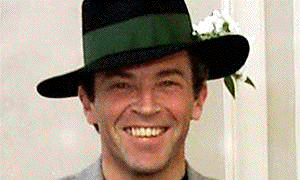
|
| Haider is considered a neo-fascist by some for his controversial beliefs... but his hat's nice. |
Jorg Haider, the deceivingly young-looking and far-right leader of Austria's coalition government is an example of the popular wave of neo-nationalist sentiment sweeping Europe today. This new nationalism is both a revival of the original ideals of nationalism and the complete opposite of those ideals. Old and new nationalism are similar in that they both value the unity of a certain culture, in Haider's case, the (white) Austrian people. They are firmly against immigration and most other multicultural policies (a similar example of these kinds of politics can be found in Canada's Canadian Alliance party). However, the neo-nationalists are different from their historic counterparts in that they favour conservatism over liberalism; return to tradition over forward-thinking political evolution.
Haider has been called both a Nazi and a moderate, but only one tag fits him for certain: political chameleon. He's been quoted as praising both the Third Reich and its S.S. However, he's also apologized for his "misquotes" several times, claiming he was misunderstood.
While most seem to feel that Haider and his kin (the late Pim Fortuyn, for example) are unhealthy for Europe's future, the conservative neo-nationalists seem to be gaining popularity. Only time will tell if Haider is another Hitler, or just a controversial conservative with a big mouth, a la America's Jesse Helms or Strom Thurmond.
Haider Fact List:
-born in Bad Goisern, upper Austria, on Jan. 26, 1950, to a shoemaker father and a teacher mother
-his parents joined the Nazi party in 1929, 9 years before Hitler annexed Austria, when it was still illegal to join the German fascists
-after WWII, Haider's parents returned to Austria to find their home in ruins; their lives were soon made likewise as they were ostracised for their Nazi connections, even though they claimed to know nothing of the concentration camps
-as a child, Haider excelled at academics and athletics (especially fencing), and was driven by his parents' downfall to prove his respectability and gain recognition
-according to Haider's childhood friend, the teenage Jorg enjoyed practicing his fencing on a straw dall with the name of famed Nazi-hunter Simon Wiesenthal pinned on it
-after graduation, Haider joined the Union of Independents, a political party that was home to many former Nazis
-Haider joined the breakoff Freedom Party and became secretary in 1976; 3 years alter he became a Member of Parliament
-after rooting out the liberals of the Freedom Party during the 1980s, Haider became governor of Carinthia in 1989
-in the early 1990s, Haider was ousted from political power in Carinthia after two controversial comments: first, he told former S.S. officers he "appreciated their efforts"; next, he stated that the "Third Reich had a proper employment policy"
-in 1995, Haider found himself in political hot water again when he told another meeting of old S.S. members that he was glad "there are still decent people in this world, people of character who have the courage of their convictions"; later that year, he referred to concentration camps as "penal camps"
-in the latter half of the 90s, Haider worked on fixing his reputation, and he regained governorship of Carinthia in 1999
-in the year 2000, Haider's party won 27% of the national vote, allowing it to join the coalition government, and he apologised for his previous Nazi remarks
-later that year, Haider "retired" from his post as leader of the Freedom Party, but remained, essentially, the main power in the party; he returned to Carinthia to govern; reportedly, he gave up his life long dream of becoming Chancellor due to international protest in the European Union over his presence in Austria's federal government
-Haider retires, again, after furor over his diplomatic visit with Saddam Hussein in Iraq; reportedly, he and Hussein discussed the "Zionist and American conspiracy" against Iraq, but Haider claims his mission was purely humanitarian, and that he was only delivering medical supplies |
